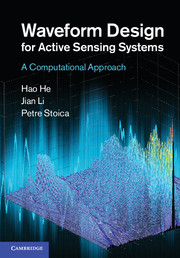Book contents
- Frontmatter
- Contents
- Preface
- Notation
- Abbreviations
- 1 Introduction
- Part I Aperiodic correlation synthesis
- 2 Single aperiodic sequence design
- 3 Aperiodic sequence set design
- 4 Lower bounds for aperiodic sequences
- 5 Stopband constraint case
- 6 Ambiguity function (AF)
- 7 Cross ambiguity function (CAF)
- 8 Joint design of transmit sequence and receive filter
- Part II Periodic correlation synthesis
- Part III Transmit beampattern synthesis
- Part IV Diverse application examples
- References
- Index
5 - Stopband constraint case
from Part I - Aperiodic correlation synthesis
Published online by Cambridge University Press: 05 August 2012
- Frontmatter
- Contents
- Preface
- Notation
- Abbreviations
- 1 Introduction
- Part I Aperiodic correlation synthesis
- 2 Single aperiodic sequence design
- 3 Aperiodic sequence set design
- 4 Lower bounds for aperiodic sequences
- 5 Stopband constraint case
- 6 Ambiguity function (AF)
- 7 Cross ambiguity function (CAF)
- 8 Joint design of transmit sequence and receive filter
- Part II Periodic correlation synthesis
- Part III Transmit beampattern synthesis
- Part IV Diverse application examples
- References
- Index
Summary
Among the tasks associated with cognitive radar [Haykin 2006], an important one is to adapt the spectrum of transmitted waveforms to the changing environment. In particular, the transmitted signal should not use certain frequency bands that have already been reserved, such as the bands for navigation and military communications; or there could exist strong emitters whose operating frequencies should be avoided. Therefore it is required that the spectral power of transmitted waveforms be small for certain frequency bands [Lindenfeld 2004][Salzman et al. 2001][Wang & Lu 2011][Headrick & Skolnik 1974].
The main focus in this chapter is on designing a discrete sequence whose spectral power is small in certain specified frequency bands. The designed sequence can be used in active sensing systems such as radar or sonar as a probing sequence. It can also be used as a spreading sequence in spread-spectrum applications such as CDMA (code division multiple access) systems.
Besides frequency notching, we also need to take into account the correlation properties of the designed sequence. As pointed out several times in previous chapters (e.g., in Chapter 1), in radar or sonar applications low auto-correlation of the probing sequence improves target detection when range compression is applied in the receiver. Furthermore, practical hardware components such as analog-to-digital converters and power amplifiers have a maximum signal-amplitude clip. In order to maximize the transmitted power that is available in the system, unimodular sequences are desirable.
Information
- Type
- Chapter
- Information
- Waveform Design for Active Sensing SystemsA Computational Approach, pp. 74 - 87Publisher: Cambridge University PressPrint publication year: 2012
